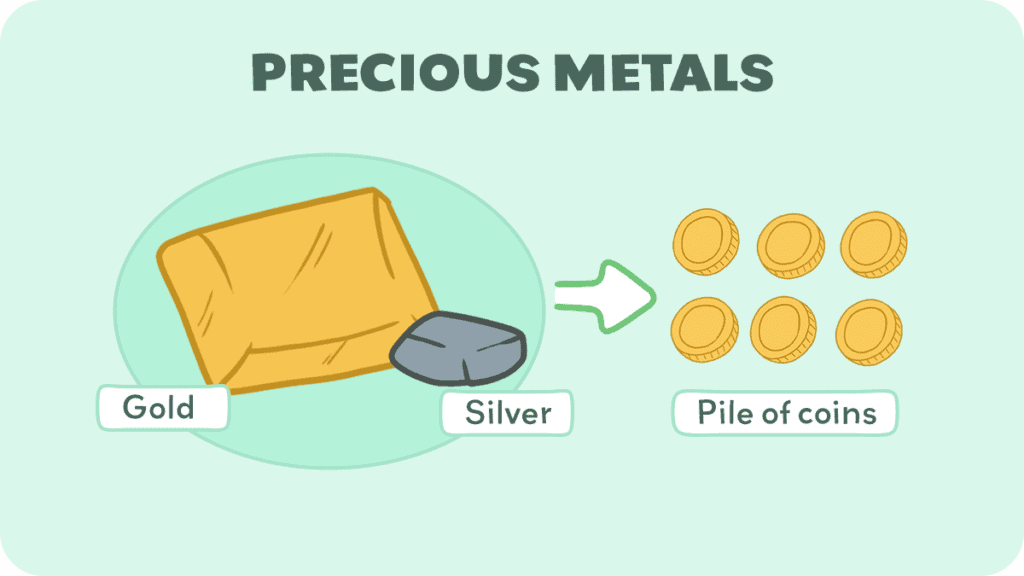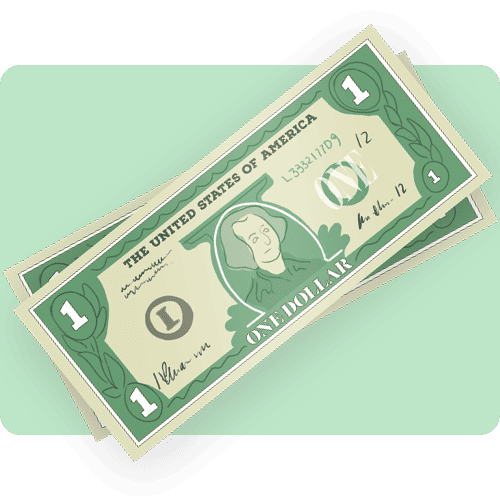Pretend you’re a pirate. After a long journey following your treasure map, you come to a desert island and find the location where ‘X’ marks the spot. You dig and unearth a treasure chest. When you open it, you discover riches beyond your wildest imagination.
What are you picturing? Is it a chest bursting with paper money of various currencies and denominations? Probably not. Based on societal tropes, you are probably picturing a chest overflowing with gold coins. Sure, there may be a diamond or a gemstone or two for balance, but the bulk of it will be gold.
Why? For most of human history, gold has been an acceptable form of money. In this article, we will look at the history of metallic money, examine why it came to be used in the first place, and its advantages and disadvantages.
From Barter to Metal Money

In the beginning, people simply traded for what they needed. However, it didn’t take long for people to realize that this could be burdensome since the person who had the item you desired might not want anything you were willing to offer.
Wouldn’t it be better if there were something that was commonly accepted? Then you could use it to get what you wanted, and the person you gave it to could turn around and use it to get what they wanted, even if it was something you didn’t have. This is referred to as a medium of exchange and is one of the three functions of money.
Secondly, money serves as a store of value. If I have a crop of grain that I have no immediate use for, the grain may rot before I can use or trade it. If I can sell it for money, that money can retain its value until I am ready to spend it.
Finally, it serves as a unit of account that can be used to measure value in the same way inches or centimeters can be used to measure length. This quickly allows you to compare the relative value of various goods and services.
Basically, money quickly replaced bartering because it served three purposes—it was a medium of exchange, a store of value, and a unit of account.
Why Metal?
The earliest form of money was commodity money—a good possessing value in and of itself that also serves the three functions of money.
Though many things have been used as money throughout the ages, including cowrie shells, peppercorns, and beans, gold and other precious metals have been the dominant form of money since ancient times.
Why? Because, in addition to being valued themselves, they have four traits that make them particularly effective as a form of money. They are:
- Durable – Precious metals do not rust. Thus, they will retain their luster, beauty, and value over time, allowing them to be used as a store of value.
- Portable – Precious metals are small enough to be carried around, allowing them to be easily transported to the market or wherever else one wishes to conduct a transaction. This makes them more convenient as a medium of exchange than something like cattle (another early form of money), which would be burdensome to move from one place to another.
- Divisibility/Measurability – Precious metals can be measured and divided, allowing you to be sure that you’re getting the value you intend from a sale and making it reliable as both a unit of account and a medium of exchange. For example, you can sell your goods for exactly three ounces of gold and be sure you are getting three ounces of gold with a basic scale. Compare this with cattle, which can vary greatly in quality and cannot be divided.
- Rarity – Finally, precious metals are rare. This is necessary for an effective form of money as it stabilizes the money supply. If something like pebbles or dirt were used, the money supply would skyrocket since people could just scoop dirt or find pebbles every time they wished to make a purchase. This would cause the money to become worthless (otherwise known as inflation).
Coin Minting

Around 2,000 years ago, the first coins were minted in the ancient Kingdom of Lydia in modern-day Turkey.
This process occurs when a government melts down the precious metal used as a commodity (in the case of Lydia, it was a combination of gold and silver known as electrum).
The melted-down metal is then poured into a cast and struck with an anvil, producing a coin. This allows the precious metal to be pre-divided into standardized units, which can then be distributed and used for commerce.
The advantage of minting is that it allowed payment to be taken by “tale,” or count, rather than weight; thus, merchants and purchasers didn’t need to weigh and divide the precious metal with each transaction. This greatly facilitated commerce and allowed the Kingdom of Lydia to prosper until it was taken over by the Persian Empire.
However, their economic success led the Persian Empire, along with the Roman and other later empires and kingdoms, to devise their own systems of coinage.
Importantly, the coins are still commodity money. That is, it is still the commodity that the coin was made of that was valuable, rather than the coin itself. This caused some problems that came with the innovation of minting.
Clipping, Sweating, and Debasement
People tried to take advantage of this fact by keeping as much of the precious metal itself while spending the coin at its face value. This led to practices such as clipping and sweating.
Clipping is when you take a coin, shave a sliver of the precious metal off of it, and then try to pass the coin off at face value.
Similarly, with sweating you would take the coins, put them in a bag, and shake them. This causes the coins to rub together and you can collect the precious metal dust that accumulates in the bag.
In either case, you get to keep some of the valuable metal, and the person you pass the metal on to gets a coin that’s less valuable than it claims to be.
A more serious problem occurs when the sovereign follows an intentional policy of debasement, or reducing the value of something.
As always, spending by the government is popular; raising taxes is not. Since the government has a monopoly on coin minting, one way they can profit from this is to debase the metal used in the coins, essentially ‘cutting’ the valuable metal such as gold with some less valuable metal.
They can then spend the now devalued coin at face value. However, when people become aware of this practice, inflation occurs, the coins become less valuable, and prices rise. This can worsen economic problems.
We saw an example of this with the Roman Empire, where the debasement ultimately contributed to the Empire’s decline.
Rise of Paper Money

As wealth grew, paper money became more attractive. It’s all well and good to carry around gold for small transactions, but in large quantities, it can become burdensome.
It became attractive to deposit one’s gold in a bank, which would then issue paper notes to prove ownership of a set quantity of gold. Soon, governments began issuing their currencies in paper notes backed by the country’s gold reserves.
However, though the paper notes were widely circulated and used in day-to-day transactions, it should be noted that they derived their value from their ability to be exchanged for gold on demand. The gold was still the item of value.
This changed in 1971 when the US exited the gold standard. Now, the paper money we use today cannot be exchanged for gold and is backed only by the word of the government that issues it. It has no intrinsic value and is known as fiat money.
Today, gold and other precious metals are valuable commodities traded on commodity exchanges. Though no longer widely circulated as money, they continue to be accepted as legal tender in several states, including:
- Utah
- Louisiana
- West Virginia
- Kansas
- Indiana
- Texas
- Oklahoma
- Missouri
Conclusion
Thank you for joining us. We hope you enjoyed learning about the history of metallic money. If you would like to learn about other interesting topics, we invite you to subscribe or check out our other articles.

